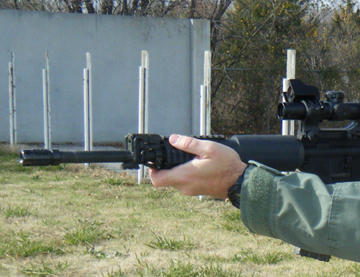My Effin-A compensator arrived packaged in a prescription pill bottle with a lable that said, Take for management of recoil systems. If symptoms persist, adjust as needed. For severe cases reevaluate technique! I thought it was an interesting way to start things off, though to be frank, I worried it might be a sign the product was “gimmicky” and that I’d be shipping it back with a patronizing mental smirk. (Not the case, as it turned out.)
A little background—I received my Effin-A compensator from Jesse at Predator Intelligence via the good graces of Christian just before he left Kit Up! Predator Intelligence wanted an evaluation done. I'd read about it before, but intentionally did not read anyone else's views on it (including his) until after I had a chance to shoot it. Christian told me to get it on the range and “try to wear it out”.
So I did.
(Actually, my brother and I did. Much as it pains me to admit it, he’s a better shooter than me. Not as good looking, but definitely a solid and experienced additional perspective to add to a review.)
Initial rapid fire string from the 25 without Effin-A Compensator, as fast as he could pull the trigger.
The Effin-A is manufactured by ARES Armor. What’s really unique about it is the way it can be customized to the shooter’s individual shooting style. I wasn’t sure what to expect, but I didn’t expect to like it as much as I did. (Nor did I expect my brother to like it as much as he did, which why it’s still on his rifle instead of back on mine. True story.)

The Effin-A installed easy, no tools required (which as anyone who knows me can attest is a Good Thing). The only thing I would say if you get one is to make sure you keep track of everything. That prescription bottle contains three locking washers and thirty-two set screws. All of mine were already in the compensator’s threaded ports, but I don’t know if that is SOP. Better to be safe and not risk losing anything.
The Effin-A is a steel cylinder ported with 7 rows of 4 threaded holes. There’s a threaded steel cap on the muzzle. The setscrews thread into the holes for ‘fine-tuning’ the gas expulsion. The cap can be removed in order to stack a second Effin-A or other muzzle device should that be necessary.
After the initial few rounds to heat up the compensator and get a feel for it, we tightened it down and then went loud.
Right off it was clear that there was almost no muzzle flip. Just as advertised, the ports vented gases to reduce recoil to almost nothing. Most recoil went straight back into the shoulder with just a barely perceptible muzzle rise, and this, it is important to note, was with all ports open.
Per the instructions, we tuned the weapon at the 10 to determine direction of climb, made adjustments, and fired a second string at 10 using a nonstandard drill for confirmation. At the time we were testing this we didn’t have immediate access to an auto-capable weapon, so we adjusted by shooting from further back (the 25).
He shot two comparison groups of 10 rounds each as fast as he could pull the trigger through two identical breeds of rifle; one had the Effin-A, the other a standard bird cage. The Effin-A group was smaller by approximately 1/3 than the other (just under 8” compared to approximately 12”). Sight picture was more easily reacquired as well.
Initial rapd fire string to tune it, from the 25, with Effin-A compensator, as fast as he could pull the trigger.
We conducted additional tuning and experimentation, including another rapid fire (just as fast as we could pull the trigger) in 10 round strings from the 25 at a standard silhouette target. Each iteration of 10 rounds were within 5” groups. (Well, his were. It’s entirely possible that my patterns would have been slightly larger, but if they had been they’d still have been tightened considerably over my control group.)
10 round string rapid fire with Effin-A now tuned, as fast as he could pull the trigger (also from the 25).
After the rapid fire, we engaged various targets with multiple rounds in various drills and found the reduction in barrel flip to be constant and significant. Acquisition of targets, and transition between targets, was universally faster and smoother with the Effin-A than without.
In summary: The Effin-A is effective and fun to shoot. Ease of installation was surprising (nice that we didn’t need a gunsmith) and the ability to “tune” it from one shooter to another is a definite plus. This compensator gets a definite ‘thumbs up’, with two caveats: we were unable to test it on burst or auto fire (though I believe it would be equally effective if not even more noticeably effective there) and it isn’t terribly “stack friendly”. Neither of us, nor any of the other tactical officers there, felt that being stacked up beside one of these (particularly in close confines) would be too comfortable if someone had to engage. Keeping in mind the limitations we tested under (we're shooters, not engineers, only had it on the range three times, only fired a couple hundred rounds through it, and it was tested in just about perfect weather) we absolutely liked how it performed.
Final tally: You’re definitely cleared hot to buy one, and hopefully someday I’ll get mine back.












